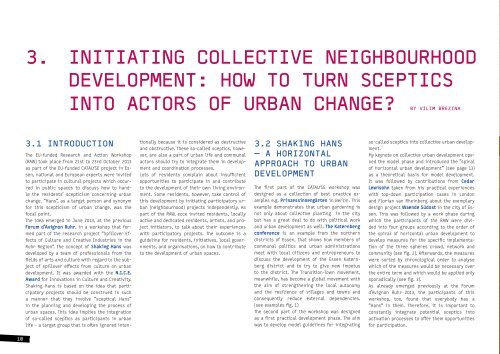CATALYSE_Shaking_Hans
CATALYSE_Shaking_Hans
CATALYSE_Shaking_Hans
Create successful ePaper yourself
Turn your PDF publications into a flip-book with our unique Google optimized e-Paper software.
3. INITIATING COLLECTIVE NEIGHBOURHOODDEVELOPMENT: HOW TO TURN SCEPTICSINTO ACTORS OF URBAN CHANGE? BY VILIM BREZINAFig. 1: Collection of best-practice examples3.1 INTRODUCTIONThe EU-funded Research and Action Workshop(RAW) took place from 21st to 23rd October 2013as part of the EU-funded <strong>CATALYSE</strong> project in Essen,national and European experts were invitedto participate in cultural projects which occurredin public spaces to discuss how to handlethe residents’ scepticism concerning urbanchange. “<strong>Hans</strong>“, as a target person and synonymfor this scepticism of urban change, was thefocal point.The idea emerged in June 2013, at the previousForum d’Avignon Ruhr, in a workshop that formedpart of the research project “Spillover Effectsof Culture and Creative Industries in theRuhr Region“. The concept of <strong>Shaking</strong> <strong>Hans</strong> wasdeveloped by a team of professionals from thefields of arts and culture with regard to the subjectof spillover effects from culture on urbandevelopment. It was awarded with the N.I.C.E.Award for Innovations in Culture and Creativity.<strong>Shaking</strong> <strong>Hans</strong> is based on the idea that participatoryprojects should be construed in sucha manner that they involve “sceptical <strong>Hans</strong>“in the planning and developing the process ofurban spaces. This idea implies the integrationof so-called sceptics as participants in urbanlife – a target group that is often ignored intentionallybecause it is considered as destructiveand obstructive. These so-called sceptics, however,are also a part of urban life and communalactors should try to integrate them in developmentand coordination processes.Lots of residents complain about insufficientopportunities to participate in and contributeto the development of their own living environment.Some residents, however, take control ofthis development by initiating participatory urban(neighbourhood) projects independently. Aspart of the RAW, ecce invited residents, locallyactive and dedicated residents, artists, and projectinitiators, to talk about their experienceswith participatory projects. The outcome is aguideline for residents, initiatives, local governments,and organisations, on how to contributeto the development of urban spaces.3.2 SHAKING HANS– A HORIZONTALAPPROACH TO URBANDEVELOPMENTThe first part of the <strong>CATALYSE</strong> workshop wasdesigned as a collection of best practice examplese.g. Prinzessinnengärten in Berlin. Thisexample demonstrates that urban gardening isnot only about collective planting in the citybut has a great deal to do with political workand urban development as well. The Katernbergconference is an example from the northerndistricts of Essen, that shows how members ofcommunal politics and urban administrationsmeet with local citizens and entrepreneurs todiscuss the development of the Essen Katernbergdistrict and to try to give new impetusto the district. The Transition-Town movement,meanwhile, has become a global movement withthe aim of strengthening the local autonomyand the resilience of villages and towns andconsequently reduce external dependencies.(see examples fig. 1)The second part of the workshop was designedas a first practical development phase. The aimwas to develop model guidelines for integratingso-called sceptics into collective urban development.My keynote on collective urban development openedthe model phase and introduced the ”spiralof horizontal urban development“ (see page 13)as a theoretical basis for model development.It was followed by contributions from CedarLewisohn taken from his practical experienceswith top-down participation cases in Londonand Florian van Rheinberg about the exemplarydesign project Waende Südost in the city of Essen.This was followed by a work phase duringwhich the participants of the RAW were dividedinto four groups according to the order ofthe spiral of horizontal urban development todevelop measures for the specific implementationof the three spheres crowd, network andcommunity (see fig. 2). Afterwards, the measureswere sorted by chronological order to analysewhich of the measures would be necessary overthe entire term and which would be applied onlysporadically (see fig. 3).As already emerged previously at the Forumd’Avignon Ruhr 2013, the participants of thisworkshop, too, found that everybody has a“<strong>Hans</strong>“ in them. Therefore, it is important toconstantly integrate potential sceptics intoactivation processes to offer them opportunitiesfor participation.1011


